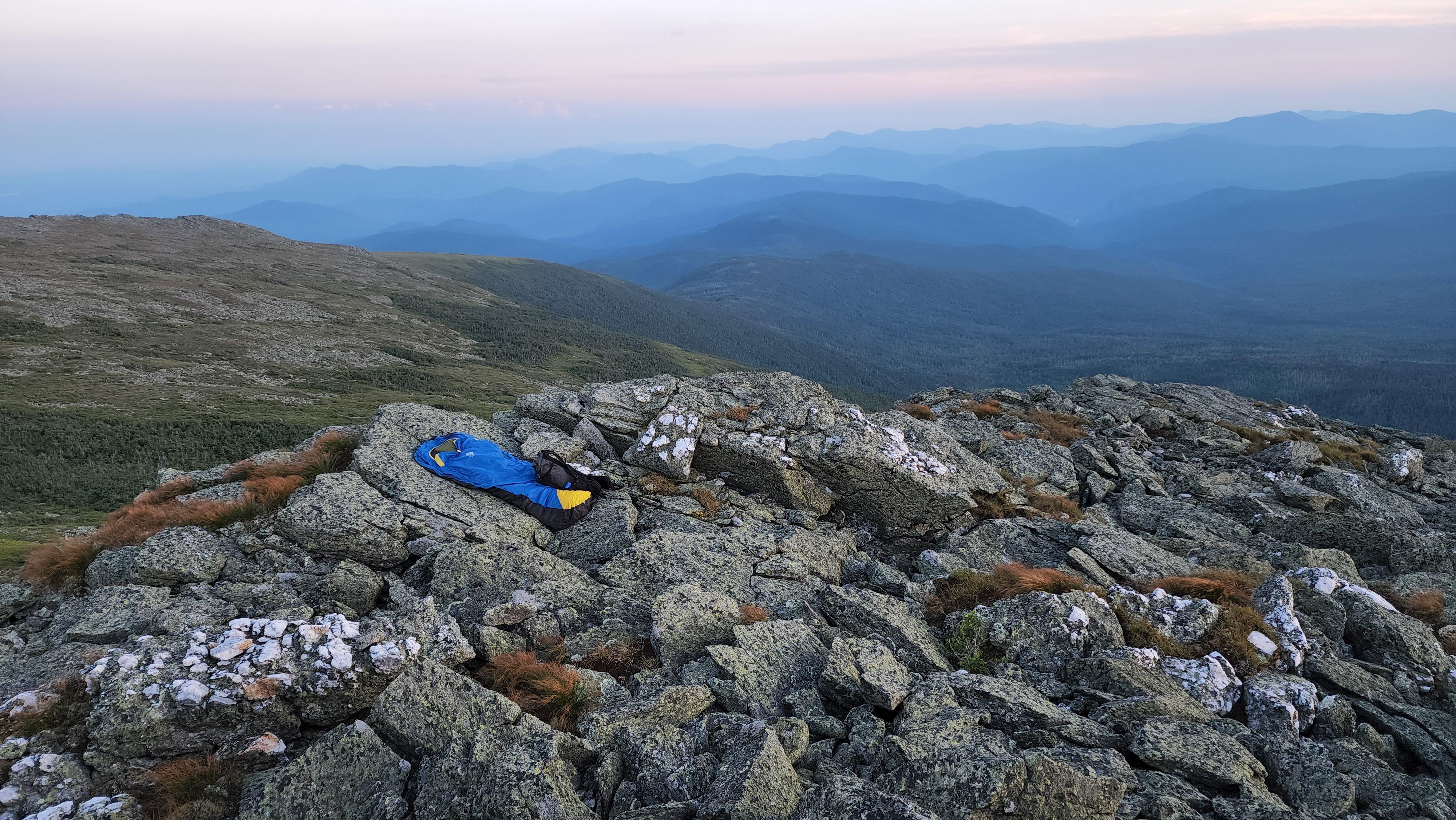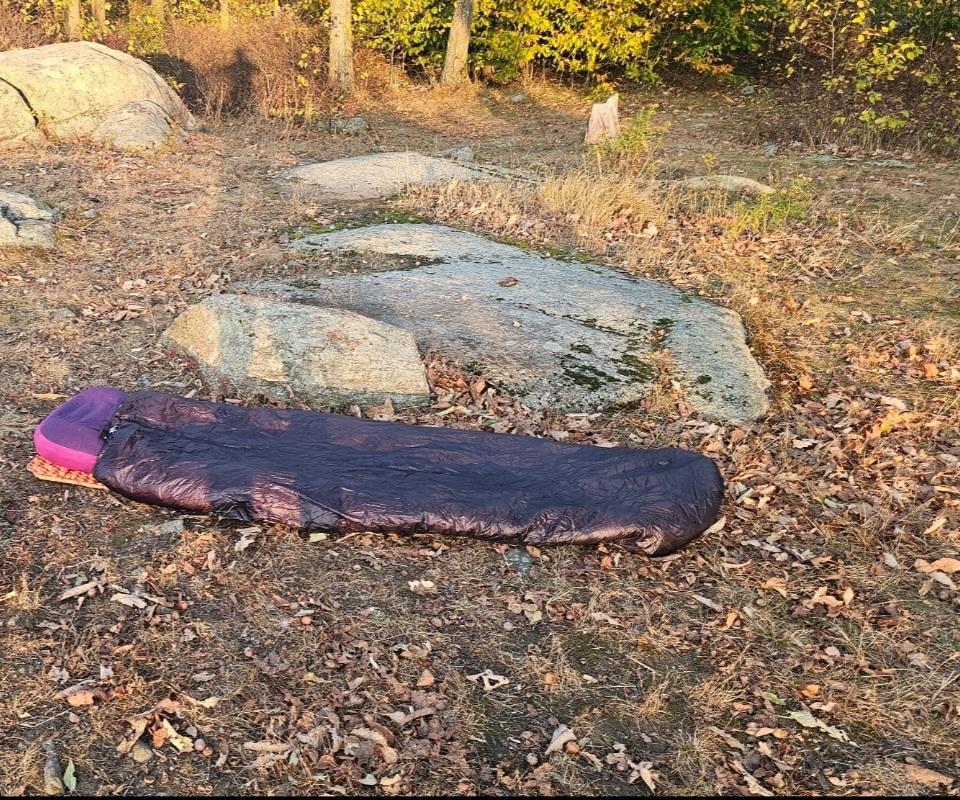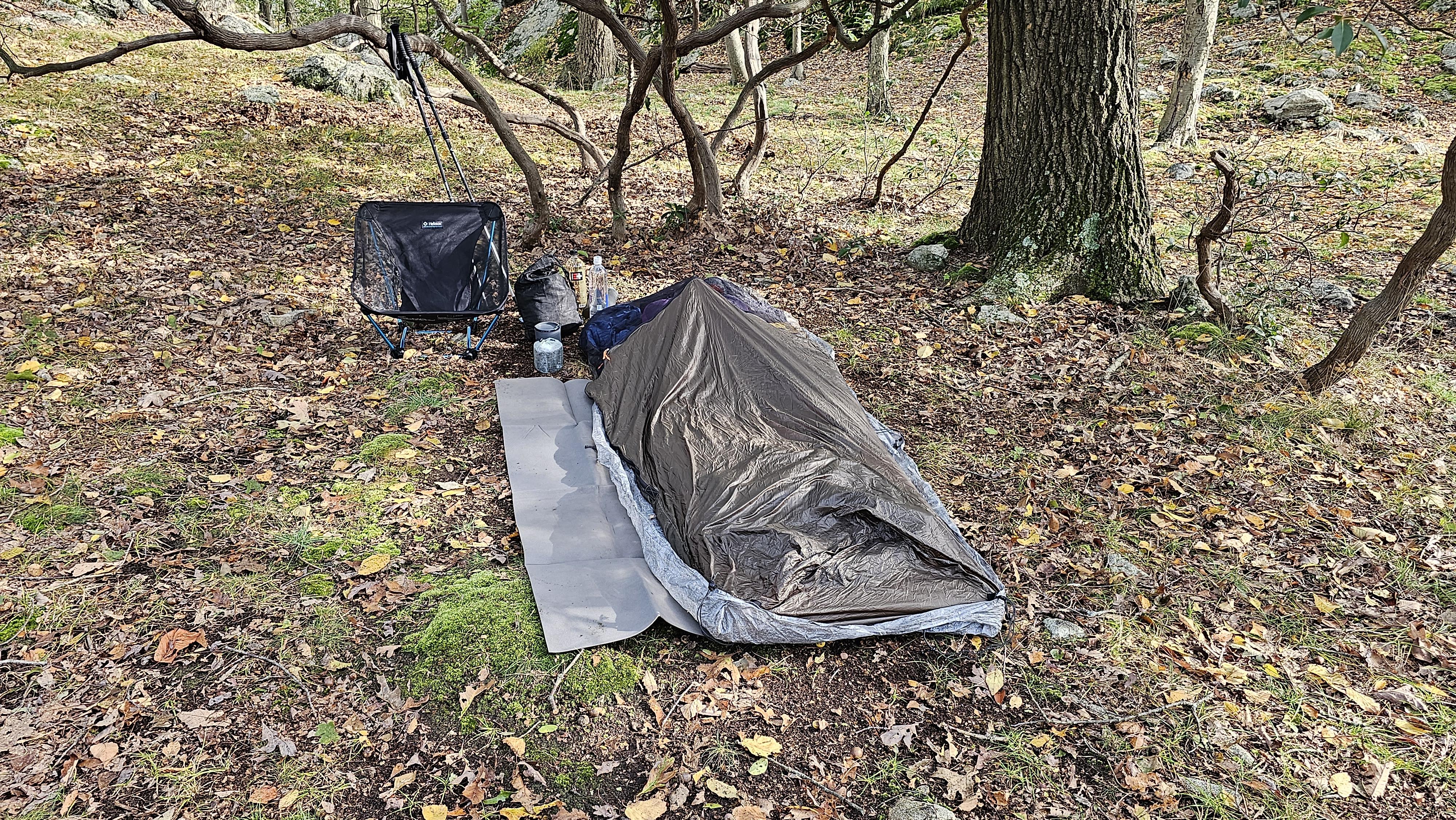Topic
Durable Bivy And/Or Bivy Floor Material For Challenging Terrain
Forum Posting
A Membership is required to post in the forums. Login or become a member to post in the member forums!
Home › Forums › Gear Forums › Gear (General) › Durable Bivy And/Or Bivy Floor Material For Challenging Terrain
- This topic has 27 replies, 9 voices, and was last updated 3 months, 3 weeks ago by
 Jerry Adams.
Jerry Adams.
-
AuthorPosts
-
Oct 16, 2024 at 5:56 pm #3820091
Looking for ideas for a lightweight material to make a “floor” for a Sierra Designs bivy bag (this one). Use it in the Northeast on rough and challenging terrain (ledge, rocks, gravel, uneven ground). Goal is to gain complete coverage by fitting the material to the shape of the floor and maybe a small “lip” along the edges (for a visual think of the bathtub floor of many trekking pole tents) to prevent inflatable pad puncture and maintain some comfort. Maximum width of bag 36 in; maximum length 90 in. (flat dimensions) I find the traditional z-pad to be very annoying for this purpose on the terrain I bivy on. It slides around, collapses itself and leaves a lot of exposure from the shifting, especially tossing and turning to get situated.
I intended to buy a roll of foam but am finding no luck getting 36 in goods for this type of foam. Mountain Laurel Designs makes a 40in x 80 in 0.250 in thick EVA pad for hammocks which may work but is not long enough for what I need. Not sure if foam is really even what I want for puncture/abrasion protection. Maybe felt padding? A lot of flooring underlayment materials sounded perfect until I calculated the weight. Was way too heavy. I’ve found other materials that could work but they are either way too heavy or would absorb water. (I only bivy like this in favorable weather but there is always the possibility of heavy dew or a quick shower). I also wonder if there is any kind of spray treatment that would improve the abrasion resistance of the nylon of the bag. I assume not but I have no idea.
Any ideas? I’m a relative newcomer to the world of ultralight thinking/hiking and I’m having a bit of a mental block trying to get past “z-fold pad” as the solution. Seen and incorporated a lot of really awesome ideas on this forum so I’m hoping to get some thoughts from the extensive knowledge here. Thanks in advance.
For a visual, below is a photo of a typical area I bivy:
 Oct 17, 2024 at 7:37 am #3820135
Oct 17, 2024 at 7:37 am #3820135Exped Doublemat? 200 x 100 x 0.4cm.
Looks to me like a sheet of 70D silnylon might also work. The industry standard would be for even higher denier count fabrics in applications that call for max puncture protection. Hilleberg for example uses 100D nylon in their Black Label tents.
Oct 17, 2024 at 10:16 am #3820146That Exped mat looks very much like Mountain Laurel’s version.
One of my more bizarre ideas/thoughts was to make a “reverse quilt” or “liner bivy” out of silnylon or similar material where I slipped it over my inflatable pad/sleeping bag but it was open on top and could be latched/clipped together much the way you would attach your quilt to an inflatable pad. This way I could still get in and out relatively easily but everything would stay in place. I could possibly line the interior of the “quilt” with thin foam to prevent it from slip sliding all over the place. I have no sewing skills though. Maybe purchasing a very warm weather/ cheap quilt and using it in this way might do the trick. Would be padded and provide some base warmth but would be far more flexible than foam. Durability wouldn’t be great but would be augmented by the bivy shell.
Oct 18, 2024 at 2:22 am #3820233In my haste, I didn’t check to convert inches to metric and just thought, “200 is longer than 80.” Good luck!
Oct 18, 2024 at 7:45 am #3820236I think this is the right stuff.
Oct 18, 2024 at 8:02 am #3820237No worries. I knew what you meant.
Oct 18, 2024 at 8:05 am #3820238How about an Ultra 800 fabric cut or stitched to the underside?
Had a question on this Bivy – heard mixed reviews of the waterproofness of this bivy. How waterproof is this bivy?
Oct 18, 2024 at 8:05 am #3820239Excellent! Thanks for that link. Custom sizes are cheaper than anything I have come across so far in standard sizes.
Oct 18, 2024 at 8:13 am #3820240The Sierra Designs bivy? I only use it in good weather and haven’t had any issues with dew or frost on it. I don’t believe it has any kind of DWR or other treatment and I would definitely not want to use it in bad weather unless I was under a tarp or some sort of shelter. Reviews consistently mention it not being waterproof. It is pretty light and convenient though. If they made a bag just like this out of Gore Tex or other similar material I would buy it in a second.
Oct 18, 2024 at 4:41 pm #3820278I have some thoughts but I want to clarify what your key desire is here. You mention foam, but also durability, and those two concepts do not go well together. A sheet of some kind of foam that covers that entire floor will weigh more than a layer of fairly durable fabric, and be much less durable. A few numbers here: 1/4″ FY20 closed cell foam from Outdoor Wilderness fabrics weighs 8.6 oz per sq. yd. by my measurements (if you get some, your actual weight will vary somewhat, that is how foam is). I had some 1/4″ foam that I got from a supplier who no longer sells it, Suluk46, that was lighter; 2.8 oz per sq yd. I have some pieces of flooring underlayment foam that I scrounged from a jobsite and so far I cannot find any more of – that stuff, at 1/8″ thick, is 2 oz per sq. yd. None of those is durable; the FY20 would be the most durable of the bunch but nothing like as tough as fabric that weighs that much. I have put some effort into finding light, thin foam and it is not easy to find – and you can be assured that the lighter it is, the less durable it is. As to puncture protection, I think foam that thin is going to do very little in that regard. I use a piece of the floor underlayment foam as a lounging groundsheet during the day and under my Neoair at night and I have no illusions that is is going to protect my pad from anything spiky.
Oct 20, 2024 at 6:31 am #3820356I agree the foam is not bulletproof and conceded in my original post that I have a mental block with being conditioned to think “foam” as a solution. The MLD 40×80 sheet weighs about 14 oz, which is a lot but I could tolerate it if it worked.
I am not expecting puncture protection from things like sticks and the like. I’m more concerned with a protruding object like a rock (as an example imagine kneeling against the fabric for a size) constantly rubbing against the bivy all night and eventually scratching through the bivy and creating abrasions against my actual sleeping pad, causing a failure.
The more I think about this the more I think a “cover” for under the bivy would be the better option. A fabric like Ultra mentioned above or similar may provide the best protection for what I am doing. If I had any sewing skills at all I think I’d try to just make a bivy bag just like the Sierra one, only in better fabric. Everything about the Sierra bivy is perfect for what I am doing, except what it is made of for material.
Oct 20, 2024 at 7:55 am #3820359Oct 20, 2024 at 1:49 pm #3820379Re: the OP’s first ‘typical bivy” photo. I’d be happy learn why those rocks at a pitched angle are a better spot to sleep than the terrain just below? that appears far more even and less cold.
Oct 20, 2024 at 1:56 pm #3820380Probably a distortion of the photo. The angle is not as severe as it looks and there was nothing flat about the surrounding terrain. Lots of gaps between rocks, jagged edges, etc. Most of the flat areas in this area would involve trampling sensitive alpine plants and grasses, a big LNT no no in the East.
Oct 21, 2024 at 1:40 pm #3820448With bivy sacks, I always went with a lighter rectangular piece of fabric like polycro (comes in various thickness) or Tyvek as every bivy sack has a waterproof floor (the waterproof/now “breathable” originally designed for climbers and the military adopted them). With a water-resistant bivy, keep the measurements smaller than the overlying tarp.
A somewhat larger piece of fabric helps delineate the sleeping>living space for getting in/out, propping oneself up to stargaze if not wanting to see mesh, etc..
Oct 22, 2024 at 1:38 pm #3820516“Most of the flat areas in this area would involve trampling sensitive alpine plants…”
A bivy takes up about the same amount of space as a goat or elk or deer bedding down at night. I think these areas have evolved to handle this sort of treatment.
Oct 22, 2024 at 1:53 pm #3820519That may be true but it is prohibited where I camp so I do not do it.
Oct 22, 2024 at 2:35 pm #3820520Read what you said about zlite pad.. but not sure how you mean. I bivy mostly upstate NY on rocky ground and granite slabs and simply use now, Nemo Switchback as my primary sleeping pad. I also bring a Gossamer Gear 1/8 thinlight pad or MLD 1/8 pad, depending which i grab. I put the 1/8 thin pad on the ground and the Switchback pad inside my bivy. Usually I only put the 1/8 pad half under my bivy so the other half is like a “door mat” .. for when I get in and out if I don’t feel like stepping or kneeling on bare ground. I toss and turn during the night and have no problem with sliding off the pad this way. Also, I use MLD superlight or MLD eVent bivy and am pretty confident in the durability of the floor. Sometimes I will use a poly ground sheet cut to size or a emergency sol orange/silver blanket thingy, also cut to size under the bivy depending on the weather conditions. I have not been using an air pad lately and find this to be possibly more comfortable. It’s definitely quicker and less hassle and 100% dependable. I use the pad against my back on a Zpack Nero and it works perfect to carry it without needing to strap it to top or bottom and hang off sides.
Oct 22, 2024 at 2:38 pm #3820521
 Oct 22, 2024 at 2:39 pm #3820522
Oct 22, 2024 at 2:39 pm #3820522Well that picture is without the bivy.. but when I use the bivy, the pad sits inside
Oct 22, 2024 at 2:43 pm #3820523
 Oct 22, 2024 at 3:27 pm #3820534Oct 22, 2024 at 3:49 pm #3820535
Oct 22, 2024 at 3:27 pm #3820534Oct 22, 2024 at 3:49 pm #3820535I don’t need pictures. I saw the movie.
Oct 22, 2024 at 3:52 pm #3820536I love the pictures of bivies in the wild
sleeping out like that is very pleasant
if it’s not raining I don’t want anything over my face to obscure the view
if it’s raining, put up the tent
Oct 22, 2024 at 3:56 pm #3820537Thanks for the detailed replies and photos dirtbag. In most circumstances like your photos I’m pretty much doing exactly what you’re doing although in some of those spots I’d probably have a trekking pole tent or freestanding 1p tent. For my initial bivy attempts I went with just the Nemo Switchback but my mid 50’s body really didn’t like it much so I added my air pad back to the set up. I’ve though about trying 2 Switchbacks but it is a fairly bulky set up strapped to the pack. That is why I was contemplating a floor of sorts the exact size of the bivy so I couldn’t physically slide off the pad and rip the floor rubbing on the rocks.
The scenario I initially described is fairly limited for me. 2, maybe 3 times a season if all the weather, wind, temps, clouds, full moon, etc all collide in the perfect set up. Then I will look for a fairly aggressive “perch” to take it all in from as dramatic a spot as I can find, which with all the restrictions in NH and ME usually means a pile of rocks. I generally sleep like crap all the time, even at home, so the hope was to improve comfort and eliminate the “man I felt like I slept on a rock all night” feeling. :) And as I initially mentioned I’m not really sure what would be best or if it’s even a solvable problem. I’m just one of those people that is forever tinkering with things, i.e. “this works pretty well….but I wonder if…..”. So I keep thinking about it.
-
AuthorPosts
- You must be logged in to reply to this topic.
Forum Posting
A Membership is required to post in the forums. Login or become a member to post in the member forums!
HAPPENING RIGHT NOW (February 11-21, 2025) - Shop Hyperlite Mountain Gear's Biggest Sale of the Year:
Our Community Posts are Moderated
Backpacking Light community posts are moderated and here to foster helpful and positive discussions about lightweight backpacking. Please be mindful of our values and boundaries and review our Community Guidelines prior to posting.
Get the Newsletter
Gear Research & Discovery Tools
- Browse our curated Gear Shop
- See the latest Gear Deals and Sales
- Our Recommendations
- Search for Gear on Sale with the Gear Finder
- Used Gear Swap
- Member Gear Reviews and BPL Gear Review Articles
- Browse by Gear Type or Brand.








